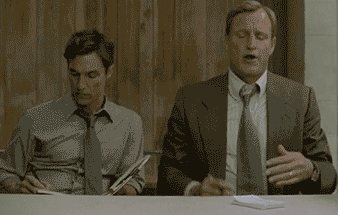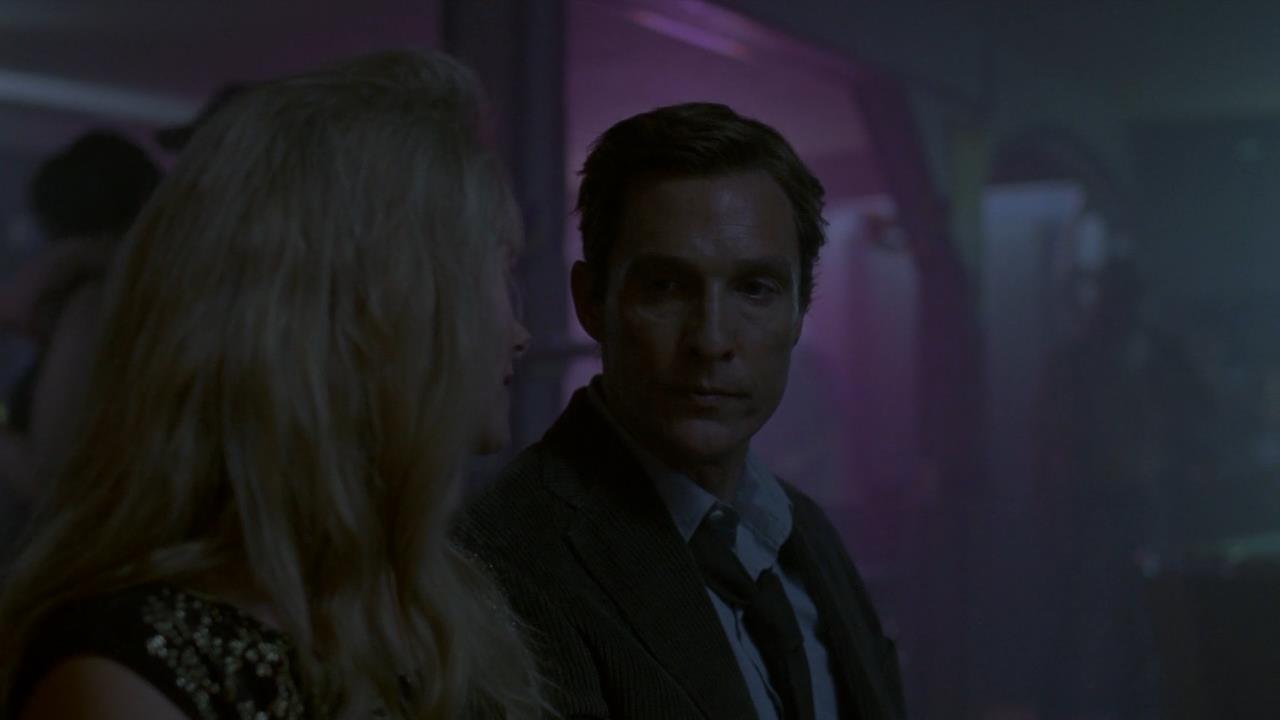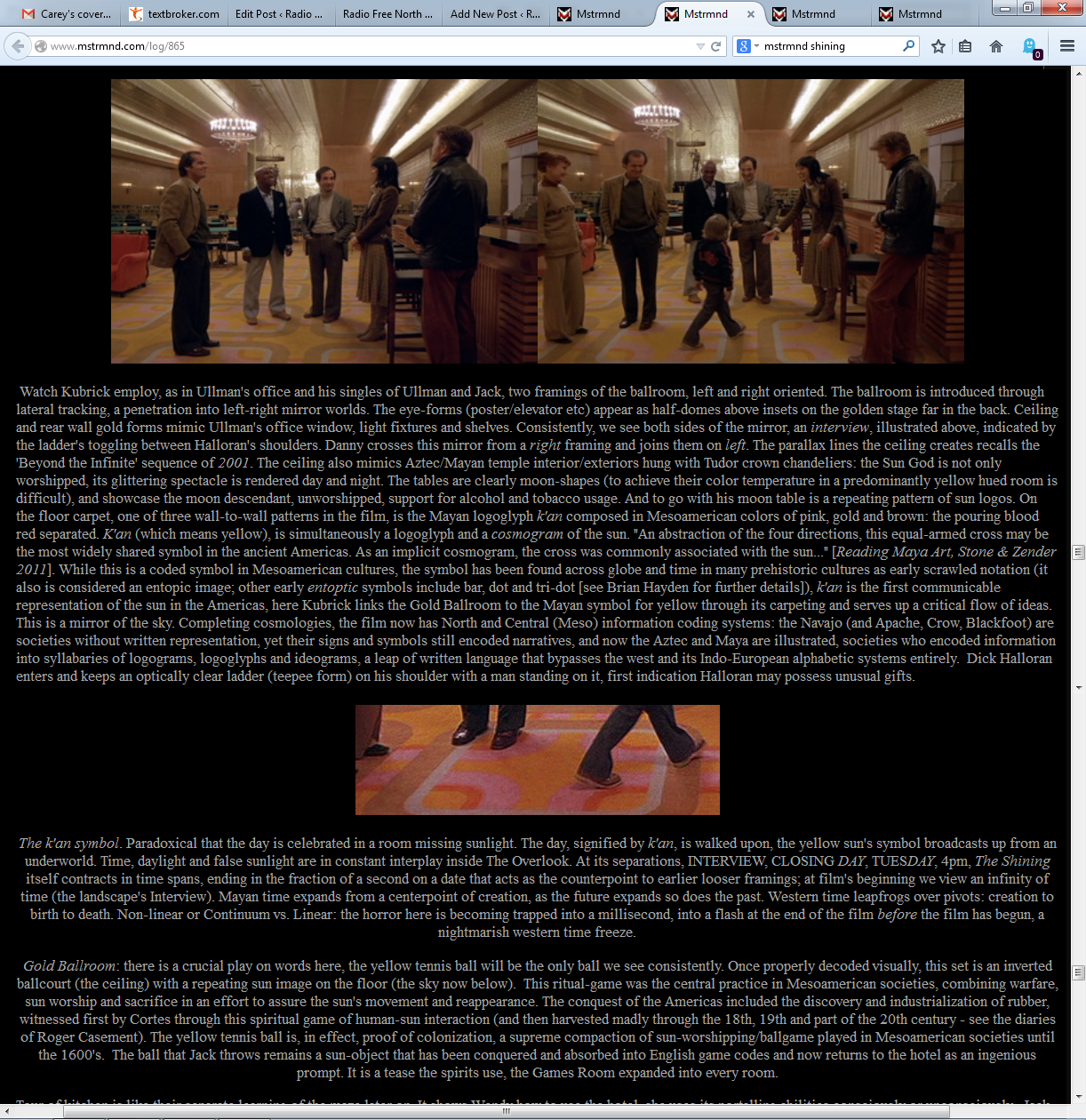Sometimes, though, the show reaches past the little symbols to the really, really big ones. Here’s an example, and I’m not pretending to understand it. One of my favorite things about True Detective is that I don’t have to pretend to understand it. I just have to write it all down so that maybe somebody else can figure it out later.
Note the violent crown hovering over Rust. I don’t want to say that this color is never used in the
series again, because even I have better things to do than scour eight hours of TV with a pantone swatch in my hand, but I certainly don’t recall it anywhere else. This scene, in the first episode, goes from violet…
…to teal.
This is the first time we see Maggie in the series.
And this here is not a thing I noticed the first time I watched the show.
In fact, I only noticed it much later, when I read an Esquire interview with Fukunaga where he’s talking about…teal.
ESQ: Any story behind the use of pink for both Beth and Maggie?
CF: I picked the underwear for both of them. Maybe I like pink underwear and unconsciously just don’t know it. [Laughs] I did not think about it. I got sent a lot of pictures of Lili Simmons [who plays Beth] in various forms of underwear and those were the ones I chose. I thought, especially for the one where she’s showing her derriere, it seemed to be the most flattering on her.
ESQ: And pink always seems to pop on screen.
CF: Yeah. Well, flesh tone doesn’t look as good, black can seem too indicative, red seems a cliché, and teal comes off not nice on people’s skin. So you end up on pink. Pink is very flattering.
Ya know, he’s right! Teal really does look sort of odd against skin.
So what is it doing here?
The purpose of this shot is clearly for me, the viewer, to find this actress’s butt attractive and thereby increase ratings for the show and fulfill contractual obligations to HBO. We all know what’s going on here. The odds of a show like this being made without a shot like this are vanishingly small at the moment, so we tend to not think about it, and this is mild stuff as HBO gratuitous butt shots go. I think in the year 2014 you can consider yourself a feminist and not be bothered by this shot in the slightest, though it makes me a little sad to say that out loud.
But why teal? Why obtrude my view of a butt with a color that the director does not believe to be good butt-coloring? Seems like a subtly discordant note meant to attract our attention, because Maggie is more important than her butt, and that is one of the important lessons that this show is trying to convey to its audience. Yes, pay attention, yes, this is butt, but brain will also be required.
This is a fair moment to talk about directorial intention, because the intention here could not be clearer. The director is saying, “I agree that her butt is important but I don’t want you to be too distracted by it.”
We start with a standard bottom-tracking shot. I didn’t pay attention to this at first, because it seemed like basic fan service. Worshiping at the altar of a nice ass; that’s something our culture does every day.
But leave it to True Detective to find something deeper.
Suddenly she turns and pivots to the right, facing the light.
And then she disappears. This looks odd, screencapped in a blog, but believe me if you watch that sequence it’s pretty odd there too. She bows down out of frame and disappears. There’s the sound of a bell ringing.
Then she’s back.
She steps forward into the frame as the camera pivots towards the light.
and throws something (we are not allowed to see what) towards the sun.
There’s an answering chime as the (unseen) toy hits the floor.
It was at this precise moment that I stopped the film and said, when the camera pans over to the toys, there’s gonna be some kind of yellow ball there. A tennis ball, a beach ball, I don’t know, but there’s gonna be a yellow ball in the shot.
And there it is!
What does this mean? Not a clue. But I know where this is coming from. They are depicting Maggie as a priestess who rings in the day. That yellow ball, perfectly isolated in space, represents the sun.
I don’t even slightly pretend to understand all the stuff about Dionysian versus Bacchanalian and sun worship versus moon worship that is apparently in the Shining:
But that is how I knew there was going to be a single yellow ball on the floor of the room.
The yellow tennis ball is, in effect, proof of colonization, a supreme compaction of sun-worshipping/ballgame played in Mesoamerican societies until the 1600’s. The ball that Jack throws remains a sun-object that has been conquered and absorbed into English game codes and now returns to the hotel as an ingenious prompt. It is a tease the spirits use, the Games Room expanded into every room.
yyyyyyyeah. Maybe. Maybe whatever’s going on here, it has something to do with that. I don’t really know.
But the value of a theory lies in its ability to make accurate predictions, so this theory deserves closer study.
My impression: Maggie is depicted, in this scene, as a priestess. A holy person, a keeper of sacred femininity. She performs the sacred and quotidian function of ringing in the day.
And maybe there’s something deeper, maybe to do with the Shining, maybe to do with the Mayans, I don’t know. I do know that mstrmnd’s essay about the Shining allowed good predictions about True Detective, so that implies that they’re either drawing from the same well or that Fukunaga/Pizzolatto/etc. are as into the Shining and mstrmnd’s essay as I am.
But implication ain’t proof.
Maybe the other toys mean something too. The big picture of the flower on the wall sure does. There’s that blue spiral toy bag that’s a flat circle; I think that means something probably, yeah, sure. There’s a television and foliage and subtle symmetry and all the other things that True Detective wants us to look for, and center in the middle of the floor, what’s that? Looks like a broken home to me.
And what happens after this? She awakens Marty, who was sleeping in the study.
Let’s return to Rust when he announces that he doesn’t sleep. Violet is a color of the night, yellow is a color of the day (in this particular scene, at least). Yellow and violet are “complementary” colors, which we think means “opposite,” because they’re opposite on the color wheel. But that’s a mistake; the color wheel is a human abstraction, and the colors are not opposite of anything. They don’t cancel each other out to invisible. If you mix them, you actually get new colors that are difficult to get through any other process.
Violet and yellow are not opposite, they are complementary. The first term was the correct one. Complementary colors represent distant points on a spectrum, but move together as strongly as a high C and a low C. Musical tones might be a better metaphor for color than positional descriptions, because we all know there’s no such thing as a musical note that’s exactly the opposite of another musical note. But there certainly are notes who influence each other more.
Violet and yellow, when placed next to each other, “vibrate.” In this scene Rust was mapped to violet and Maggie was mapped to yellow. Why? Because they’re Night and Day, I guess.
Do you have to know all this stuff before you start making the movies? Or can you just sort of figure it out as you go along?
I don’t know, but just to be sure I went into the story that I’m working on right now and added a lot of semi-mystical stuff about the difference between day and night. Not sure where this train is going but I want to be on board.
tl;dr the movie subtly depicts Maggie as the Priestess of the Day, the opposite of Rust’s Priest of the Night. Her role in this film not exactly sexual as much as it is the mystical priestess of sexuality. She is not a mother, but a symbol of femininity, and that includes being a mother. What that means I obviously cannot tell you.
This is an addendum to a six-part series about True Detective.
Here are the other five-and-a-half chapters:
Chapter One
Chapter Two
Chapter Three
Chapter Four
Chapter Five
Chapter Six


![TD s01 (1).mkv_snapshot_25.52_[2014.05.07_05.25.19]](http://www.unnecessaryg.com/blog/wp-content/uploads/2014/06/TD-s01-1.mkv_snapshot_25.52_2014.05.07_05.25.19.jpg)
![TD s01 (1).mkv_snapshot_26.03_[2014.05.07_05.25.46]](http://www.unnecessaryg.com/blog/wp-content/uploads/2014/06/TD-s01-1.mkv_snapshot_26.03_2014.05.07_05.25.46.jpg)
![TD s01 (1).mkv_snapshot_26.06_[2014.05.07_05.25.51]](http://www.unnecessaryg.com/blog/wp-content/uploads/2014/06/TD-s01-1.mkv_snapshot_26.06_2014.05.07_05.25.51.jpg)
![TD s01 (1).mkv_snapshot_26.08_[2014.05.07_05.25.55]](http://www.unnecessaryg.com/blog/wp-content/uploads/2014/06/TD-s01-1.mkv_snapshot_26.08_2014.05.07_05.25.55.jpg)
![TD s01 (1).mkv_snapshot_26.10_[2014.05.07_05.25.59]](http://www.unnecessaryg.com/blog/wp-content/uploads/2014/06/TD-s01-1.mkv_snapshot_26.10_2014.05.07_05.25.59.jpg)
![TD s01 (1).mkv_snapshot_26.11_[2014.05.07_05.26.02]](http://www.unnecessaryg.com/blog/wp-content/uploads/2014/06/TD-s01-1.mkv_snapshot_26.11_2014.05.07_05.26.02.jpg)
![TD s01 (1).mkv_snapshot_26.12_[2014.05.07_05.26.11]](http://www.unnecessaryg.com/blog/wp-content/uploads/2014/06/TD-s01-1.mkv_snapshot_26.12_2014.05.07_05.26.11.jpg)
![TD s01 (1).mkv_snapshot_26.13_[2014.05.07_05.26.15]](http://www.unnecessaryg.com/blog/wp-content/uploads/2014/06/TD-s01-1.mkv_snapshot_26.13_2014.05.07_05.26.15.jpg)
![TD s01 (1).mkv_snapshot_26.17_[2014.05.07_05.26.21]](http://www.unnecessaryg.com/blog/wp-content/uploads/2014/06/TD-s01-1.mkv_snapshot_26.17_2014.05.07_05.26.21.jpg)

F*ckin? amazing points here. I?m very happy to appear your post. Thank you lots and i am having a look ahead to touch you. Will you kindly drop me a mail?
Achei muito lítico a sua forma de expressar.
Gostei de tudo em seu sítio.
Really don’t overlook out on distinctive in game situations along with challenges that produce our Metin2 Private Server distinguish themselves from the remainder.